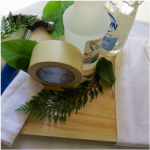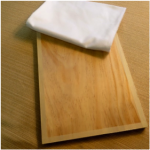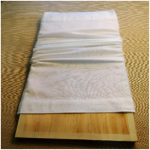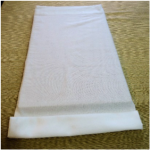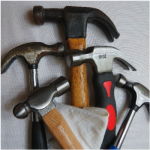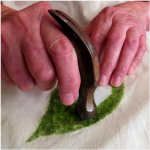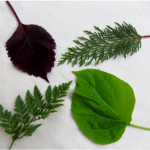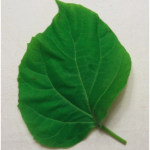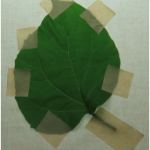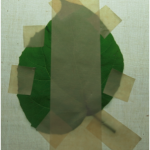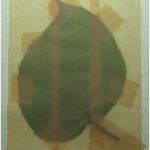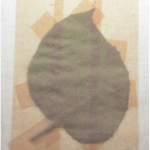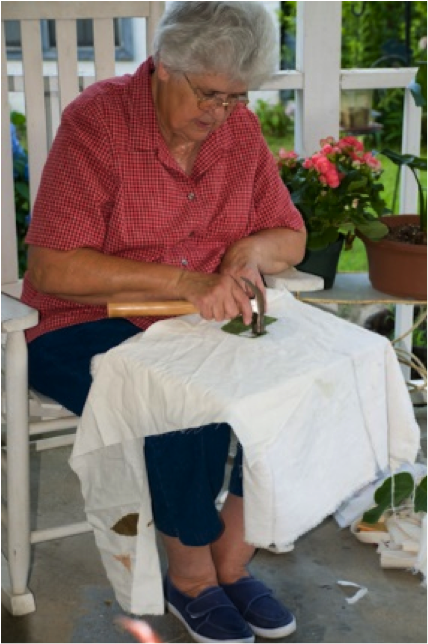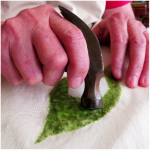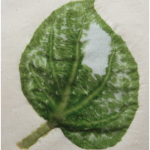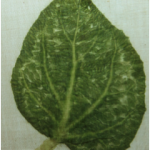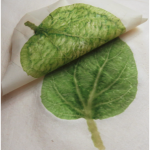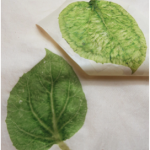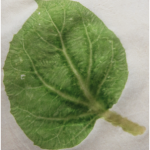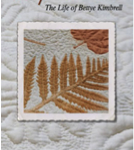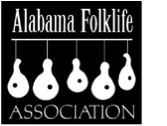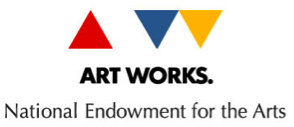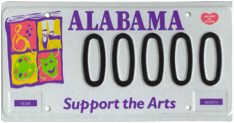Guide to Cherokee Leaf Pounding
Sylvia G. Stephens, under the auspices of the Alabama Folklife Association in 2014, compiled a detailed, illustrated guide to Cherokee Leaf Pounding as done by Bettye Kimbrell. This page presents those instructions in a web friendly format. You may download the original, printer friendly, document at the link below.
Cherokee Leaf Pounding Instructions
Supplies
- Hardwood Board Covered with White Fabric — Choose a wooden board that does not chip, crack or splinter
- Hammer with Flat Steel Head — Choose a small, lightweight hammer that’s easy to handle as you grip and hold the hammer head in the palm of your hand
- Dark Green Leaves — Fresh, dark green leaves make better designs
- 100% Cotton Muslin Cloth — Unbleached, off-white muslin that you can see through is best — Polyester and synthetic fabrics do not easily absorb the stain
- Wide Masking Tape — Use the off–white, natural color tape that’s about 1½-3 in. wide
Hard Wooden Board – Covered for Pounding
- Select a solid, smooth, wooden board — Avoid plywood, particle board or pieced cutting boards
- Boards can be cut to size at your local home supply or hardware store — A good lap size is about 12 in. wide x 18 in. long x ½ in. thick
- Edges and corners may be covered with masking or duct tape to prevent snagging fabric
- The board is covered with a white cloth to add a little “cushioning” when pounding — Use an old, thinly worn white towel or a piece of thin white flannel fabric (not too thick, not too thin)
Choose the Right Hammer
- Choose a hammer with a smooth, flat steel face — not a rubber mallet.
- The hardness of the steel head is needed to smash the chlorophyll out of the leaf so that it stains the fabric.
- Select a hammer that is the right size and weight for your hand to allow for continuous pounding. The correct weight helps avoid injury to your wrist, arm and shoulder.
- Keep a small scrap of cloth handy to wipe off tiny plant particles or stain that may accumulate on the head.
Select Leaves for Pounding
- Select dark green, “soft” tree or plant leaves. — Darker colors and leaf texture are important — Fruit and vegetable leaves may be too soft
- Keep leaves “fresh” with a moist paper towel inside a plastic resealable or brown paper bag.
Suggested Leaves
— Hydrangea
— Kudzu
— Pine, Fir
— Fern
— Philodendron
— Wild Honeysuckle
— Hickory
— Hedges
— Coleus
— Gingko
Use Cotton Fabric
 100 percent cotton cloth is best
100 percent cotton cloth is best
- Unbleached, off-white, 100 % cotton muslin fabric is recommended. Select a quality, weight and thickness of muslin suitable for your project. Muslin can be 36-108 inches wide.
- Choose an off-white muslin texture that you can see through when pounding.
- The muslin may be washed or unwashed.
Prepare Leaf for Pounding
- Select leaves for your project.
- Choose only the leaves you intend to pound that day. Keeping leaves overnight or for several days causes the leaves to dry out and color intensity to decrease.
- If leaves must be stored, place them in a damp cloth or paper towel inside a resealable plastic bag and keep them in the refrigerator
- The leaf can be turned “face up” or “face down” on
the cloth, depending which way it lies flatter.
- Use masking tape to “baste” the leaf to the muslin
fabric. - Start by taping down the leaf tip and stem. Then
tape the outer edges down just enough to keep the
leaf flat on the muslin.
- Tape down and cover the entire leaf onto the fabric with the masking tape.
- Overlap edges of the masking tape to cover and enclose the leaf under the tape.
- Be careful to keep the leaf, stem and all outer edges flat when taping.
Get Ready to Pound
Flip and Pound
- After the leaf is taped to the cloth, flip it over so the FABRIC SIDE IS UP and the taped side is down.
- You should be able to see the size and shape of the leaf through the fabric.
- Smooth over the taped leaf to be sure it is flat before you start pounding.
Ready, Sit, Pound!
- Sit in a chair with your feet flat on the floor so that your lap is level.
- Position the cloth-covered pounding board across your lap.
- Spread the taped leaf — fabric side up — over the board.
- Notice how the hammer is grasped by the hand under hammer claw and around the cheek for pounding.
Pound the Leaf
Pounding must be firm–yet gentle–to release the leaf stain and so the fabric is not damaged.
Start Pounding with the Fabric Side Up
- With fabric side up, use the hammer to lightly pound around the outer edge of the leaf through the muslin fabric.
- Tilt the hammer at a slight angle as you beat through the fabric so that the bell edge of the hammer head crushes the leaf and releases the chlorophyll stain to be absorbed into the fabric.
- Then pound over the center area of the leaf area to continue to release the chlorophyll stain.
- When you are satisfied with the shape and color of the stained leaf, flip the cloth to the underside to peel away the masking tape.
Peel Away the Masking Tape to See the Leaf Design
Remove the Taped Leaf
- After the leaf pounding — and staining — is complete, flip the cloth back over to remove the masking tape.
- Starting at the outer edges of the masking tape, gently lift and peel the taped leaf away from the cloth to reveal an interesting leaf image with designs as beautiful and intricate as the original leaf.
Fabric Care for Natural Leaf Designs
After the masking tape is removed, swish the cloth in a mixture of vinegar and water to set the design
- Mix one pint of vinegar in one gallon of water.
- Loosely soak the fabric in the vinegar-water solution for approximately 15 minutes to an hour to “set” the chlorophyll stained design into the fabric.
- Once the design is set, wash and gently scrub the cloth using a white or clear detergent or dishwashing liquid to remove any plant particles or leaf residue. Rinse the fabric until the water is clear.
- Gently wring — and dry the cloth in a machine dryer or hang to dry.
How to Make a Quilt Out of Fabric with Cherokee Leaf Pounding Designs
Make your quilt using traditional or contemporary quilting techniques. Use a “whole cloth” as Bettye Kimbrell describes in the book about her life, Out of Whole Cloth: The Life of Bettye Kimbrell. Use the patchwork approach and piece together blocks of fabric to create a quilt top that can be used in a quilt sandwich.
Tips for Using the Leaf Designs
Pound various sizes and types of leaves into the cloth to make table napkins, table runners or clothes. Embellish the leaf with assorted beads and fabric colors to create unlimited designs.
Resources
National Endowment for the Arts: Bettye Kimbrell, 2008 NEA National Heritage Fellow
http://arts.gov/honors/heritage/fellows/bettye-kimbrell
Masters of Traditional Arts Education Guide: Bettye Kimbrell, Quilter
Watch documentary films, listen to recordings and see photographs of Bettye Kimbrell and her quilts by NEA photographer, Alan Govenar. http://www.mastersoftraditionalarts.org/featured-artists/bettye-kimbrell/
Book: Out of Whole Cloth, The Life of Bettye Kimbrell by Joyce Cauthen
You can purchase the book at Amazon, through iTunes and at Barnes and Noble
Sponsors

